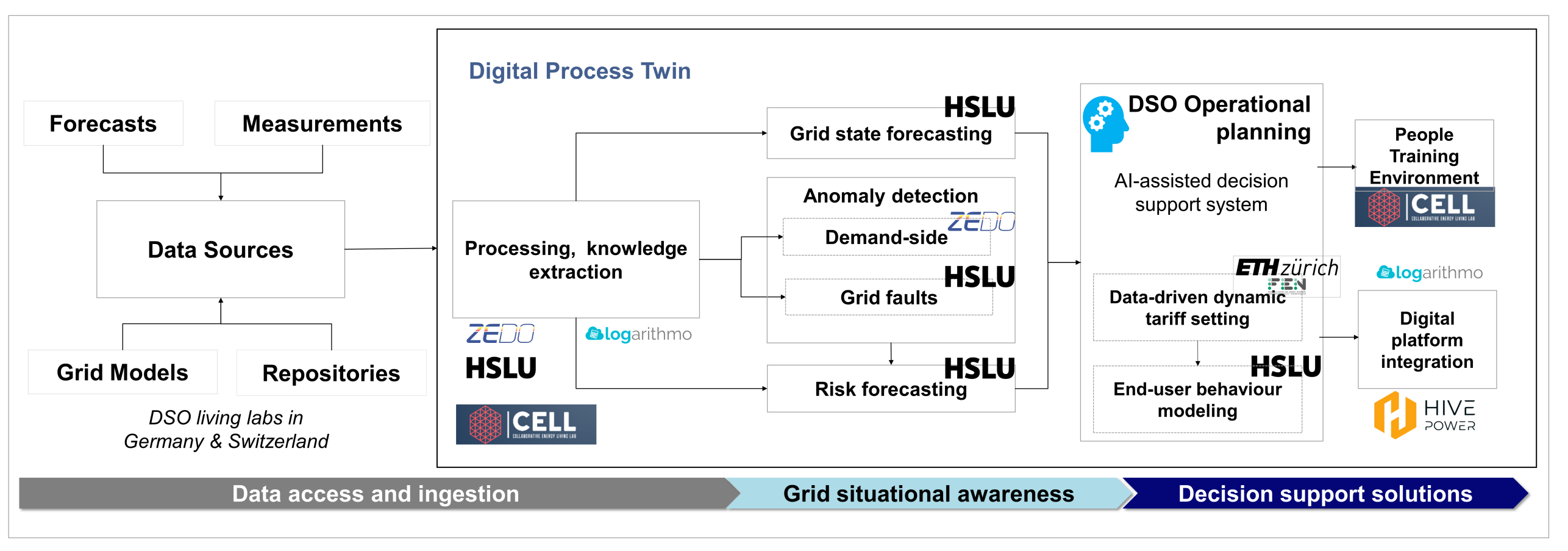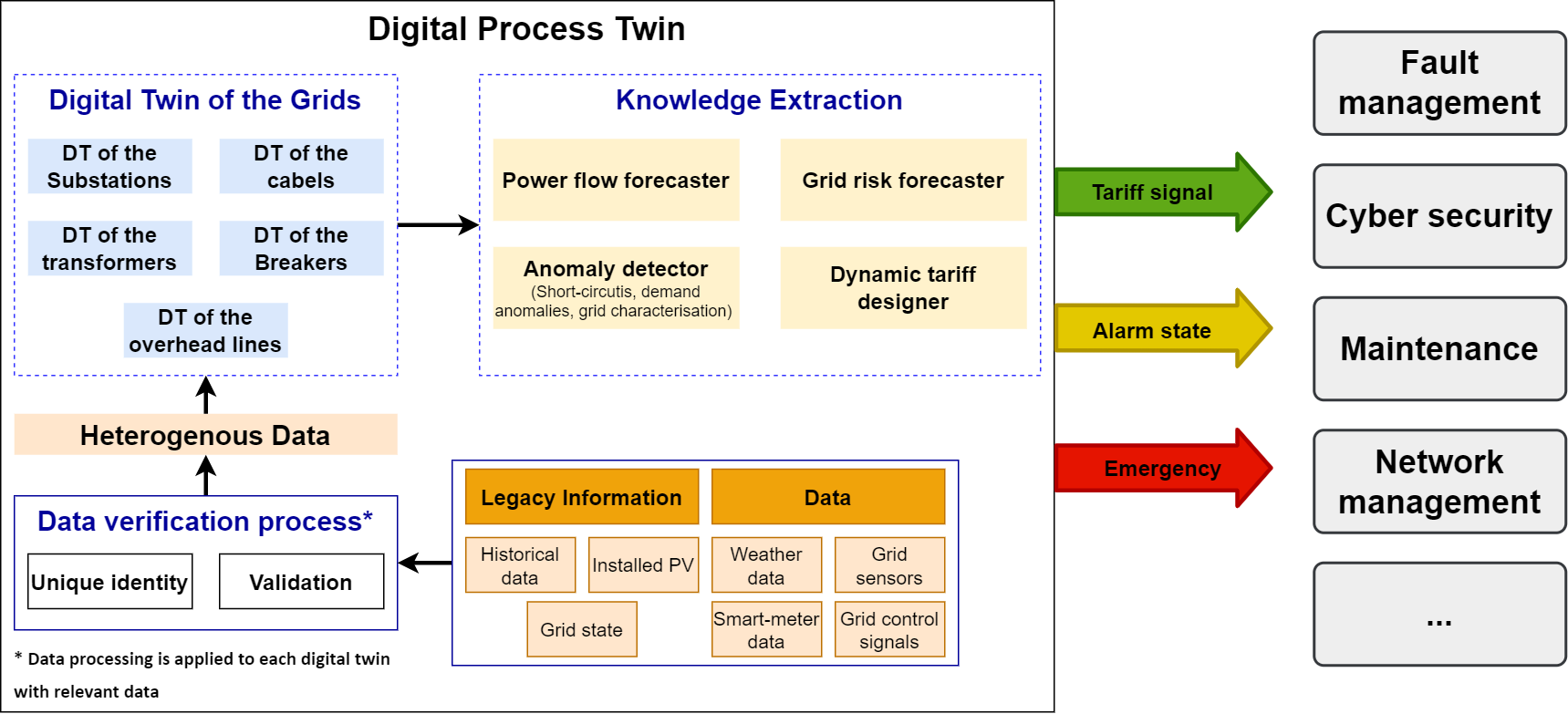ERA-Net AISOP
AI-assisted grid situational awareness and operational planning

Partners: ETHZ (FEN), HSLU, external page Romande Energie, external page Hive Power in Switzerland and external page zedo e.V., external page Logarithmo, external page ASEW (Netzwerk von Stadtwerken für Stadtwerke), and external page WWN (Westfalen Weser Energie) in Germany
Duration: 2022 - 2025
Funding: SFOE - external page ERA-Net Joint Call 2020 (MICall20) on digital transformation for green energy transition
Project Leader: HSLU & ETHZ (FEN)
Project Team: Dr. C. Yaman Evrenosoglu, Dr. Adamantios Marinakis, Dr. Turhan Demiray
Benjamin Bowler, external page Dr. Braulio Barahona Garzon & external page Prof. AntoniosPapaemmanouil at HSLU
external page Prof. Christian Rehtanz & external page Dr. Ulf Häger at zedo e.V.
external page Project website at SFOE
external page Dedicated project website
external page Interim report 2024
CIRED Vienna 2024 [external page article, Download poster (PDF, 3.8 MB)]

AISOP aims to create an AI-assisted decision support system for the electric distribution system operators (DSOs) to drive decarbonisation that is underpinned by advanced digital technology. The decision-support system securely and privately acquires, processes, interprets, and exploits data for the benefit of DSO operational planning. In this context, AISOP expands data-driven techniques for improved operational planning in distribution/local grids with high shares of DERs by integrating AI/ML-based solutions, enhanced situational awareness and market incentives. Within the proposed project we combine
(i) data access and ingestion,
(ii) distribution grid situational awareness,
(iii) decision-support for distribution grid management,
(iv) dynamic tariffs, and
(v) digital platform integration with exploitation through test and training environments.
The role of FEN: Co-leading the consortium with HSLU. Leading the activities in WP4 on "decision- support solutions" focusing on developing ML-based identification of dynamic tariff for prosumers and consumers.
Decision support systems for distribution system operations were first proposed in literature as early as 1995. They comprised a modular approach that included fault diagnosis and numerical analysis relating to load flows. Today, some projects are developing concepts or tools for distribution network planning decision support (e.g. NREL) but tools for operational planning are focused on TSO use cases, including voltage control, transient stability, loop control and frequency events (Electra). They have not considered system capacity or fault detection, nor DSO use cases. Some multi-purpose pre-commercial tools are available, based on applied research (GridOPTICS CORE) but they have not been widely adopted. Research on decision support systems targeting LV-connected distributed RES is more common, including taking into account numbers, location, type, and size of DG; heating, electricity, transport, and combinations of RES and battery systems to achieve load-generation balance. Tests have included basic piloting on microgrids, without being integrated into a DSO platform.
The AISOP concept of the Digital Process Twin is an innovative approach to connect the individual data silos along the different processes within the operational planning for a DSO and exploit them. In other domains, there are already comparable approaches in the combination of data silos, but not relating to integrated approaches to data exploitation for the DSO in the context of operational planning. Within the ERA-Net-funded project EPC4SES the focus is on Digitial Buidling Twins for Smart Energy Systems, while DiGriFlex developed real-time distribution grid control and flexibility provision, without integration into DSO processes.
In terms of the AISOP building blocks, for anomaly detection, fault identification using network measurements and AI is at TRL5. A small number of pilot projects were completed (e.g. eBalance, SYNAPS, FORESIGHT) based on early commercial products (e.g.GSmart, Kelvatek, VoltNet). Most existing academic work focuses on fault detection in MV networks and faults that are not characteristic of LV networks. Algorithms for the identification of supply and demand anomalies have found limited application in research projects. Within the EPR (European Pattern Recognition) project, one practical application focused on the field of pattern recognition in consumption behavior. However, the future influence of prosumers and deviating anomalies has not been investigated. Furthermore, the identification of grid anomalies is being investigated in the Netz-Patron project to what extent industrial customers can regulate themselves in a grid-serving manner without DSO process integration. The coordination between the distribution production units, and electricity and heat demands should be enhanced, specifically with the AI techniques to better understand the consumer behavior and production pattern.
Today, ML for DER forecasting (demand, renewable generation, electricity prices, asset aging) is in a mature stage, used by the industry. However, ML for integrated classification of system security or situational awareness is used by a few pioneering TSOs, most notably RTE (the French TSO). LV network sensors, such from Depsys, are in early stages of commercial exploitation and are not widely applied in DSO networks for grid situational awareness.
When presented with an improved situation awareness of the grid, the DSO is able to take corrective action through digital platforms for local energy markets (LEMs). LEMs have the potential to affect behaviour in distribution networks and so may subsequently influence congestion. Network tariffs can also have an impact on changing prosumers’ behaviour and subsequently impact the network, including reducing in power peaks up to 11% (consumer level) and 7% (neighbourhood level). Research has identified that more dynamic network tariffs, when compared to current practice (i.e., spatial and temporal varying network tariffs), could be a signal to prosumers to change unwanted behaviour that led to undesirable consequences in local networks. However, while digital platforms are being developed in various projects (COORDINET, INTERRFACE), their integration with decision support for operational planning is novel.
Advancing the state of the art in the topics described requires an increasing amount of data. The collected data results in silos that are often isolated, which means they are interpreted as independent in their data silos and not analyzed for possible correlations or usage. There are also significant constraints around data access and exploitation in the context of digitalisation, driving the need for privacy preserving approaches to data exploitation. Federated learning is a new field and has been applied in a very limited capacity in distribution systems, and its implementation on the edge is also highly innovative.

